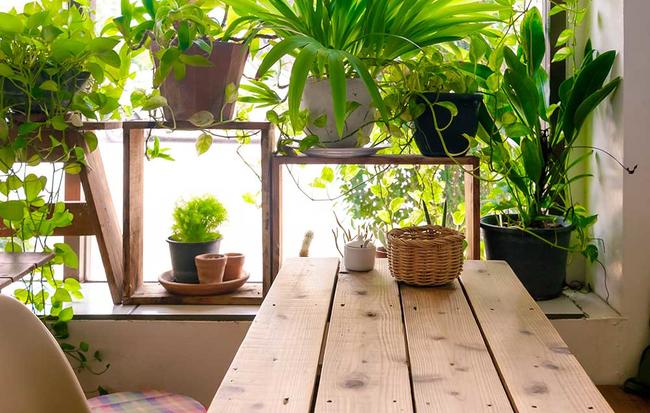Anyone who’s ever been seriously depressed or knows someone who has been understands that it’s not something you can easily “snap out of,” and that working with a mental health professional is often crucial. Most people do best with a combination of therapy and medication, but other lifestyle factors may also play a role: For example, several studies have found that people who have a strong network of friends are less likely to become depressed.
Just as surrounding yourself with positive people may help keep your mood up, your surroundings matter, too. Of course, no one is suggesting that you can cure clinical depression by redecorating your home, but you just might be surprised by how much small tweaks can help. Whether you’re looking for ways to complement your current depression treatment or just want to do whatever you can to maintain your already sunny disposition, try these tricks to transform your home into a happier place.

Flex your green thumb.
There’s little doubt that spending time in nature is good for your soul, and research has found that simply walking outdoors lowers feelings of despair. While getting some fresh air is pretty much always a good idea, you can also take steps to bring nature indoors. “If you live in an urban setting, try putting plants on your balcony or windowsill,” says Jean M. Larson, PhD, manager of the Center for Therapeutic Horticulture and Recreation Services at the Minnesota Landscape Arboretum and an assistant professor at the University of Minnesota Center for Spirituality and Healing.
While just seeing greenery in your home may be helpful, you should also know that plants emit compounds that may help cut your stress level and even lower your blood pressure. “We’re hardwired to connect with nature,” says Larson. (Here are 13 ways to lower your blood pressure naturally.)

Paint (or hang) a mural.
So much of our indoor environment is artificial, which is understandable. But if you’re looking to strengthen your connection to nature, consider choosing a large painting or mural that reflects what’s going on outside your home. “There are some beautiful murals, including decals that are easy to hang, that you might put on a wall in your living room,” says Larson. She suggests choosing something that’s native to your local area, so if you live in the mountains don’t opt for a beach scene and vice versa. “You want to pick something that’s familiar and pleasing,” she says. You can find a variety of affordable options here, or consider commissioning a local artist to paint a scene of your choosing.

Enjoy the view.
If you’re lucky enough to have a beautiful garden, make sure you can see it. Ditch your heavy curtains and shades, and if you’re in the market for new windows go big. “When I was designing my home I chose as many windows as possible, because I wanted to see all around the house,” says Larson. Not only is seeing nature important, but so is letting in lots of light: It helps keep your circadian rhythms on track, so your body naturally knows when to act alert and when to feel sleepy so you can get the rest you need.

Use a light box.
Exposure to natural light is critical for everyone, though it seems to be especially important for those who suffer from seasonal affective disorder (SAD), a type of depression that occurs in the winter when the days are shorter. Interestingly, at least one preliminary study has suggested that even those who suffer from year-round depression may benefit from taking in ample light in the morning hours.
If you’re not currently getting enough natural rays in the AM, consider setting up a light box in your bedroom or kitchen: This gadget, such as the Verilux HappyLight, provides the same type of light produced by the sun but filters out harmful UVs. Try using it for 30 minutes shortly after waking. (Check with your doctor first if you’re taking medication for depression.)

See red—or orange.
“The easiest way to tweak your home is to change paint colors,” says interior designer Suzanne Falk. “Warm colors can evoke feelings of happiness or optimism.” Her pick: A red shade like Benjamin Moore Shy Cherry.
Moll Anderson, lifestyle expert and author of Change Your Home, Change Your Life with Color, likes orange, which is “a refreshing, stimulating, and positive hue that encourages socialization and creativity.” Go bright in an entertaining space, or try softer shades like terra cotta, peach, or pale apricot. “They have a broad appeal and are welcoming, comforting, and cheerful,” she says.
Although red and orange tend to be widely associated with joyfulness, color preference is deeply personal. “Our love or dislike of a color is based on our own unique experiences,” says Moll. Bottom line: Think about how a particular color makes you feel and pick what you love.

Add splashes of color.
If repainting your home (or even a room) isn’t on the table, try adding little pops of color. “You can easily change the vibe by swapping out some key accessories,” says Moll. “Choose your favorite color to infuse into your life in fabrics, pillows, draperies, or an accent rug. When it comes to the bathroom, go for brightly-colored towels, robes, and bath mats. A simple folded throw over the arms of a sofa and a colorful collection of books or a tray will pop color into any space in a flash.”

Get personal.
“Design elements in your home are very important when it comes to impacting your mood and mental health,” says Falk. She recommends including items that evoke positive memories and sensory experiences. “It’s easy to brighten your home with items that make you happy, such as a frame with a photo of your family or pet, textured pillows for the couch, or just a soft blanket that pulls you in to snuggle up on the couch.”
Source: Prevention












